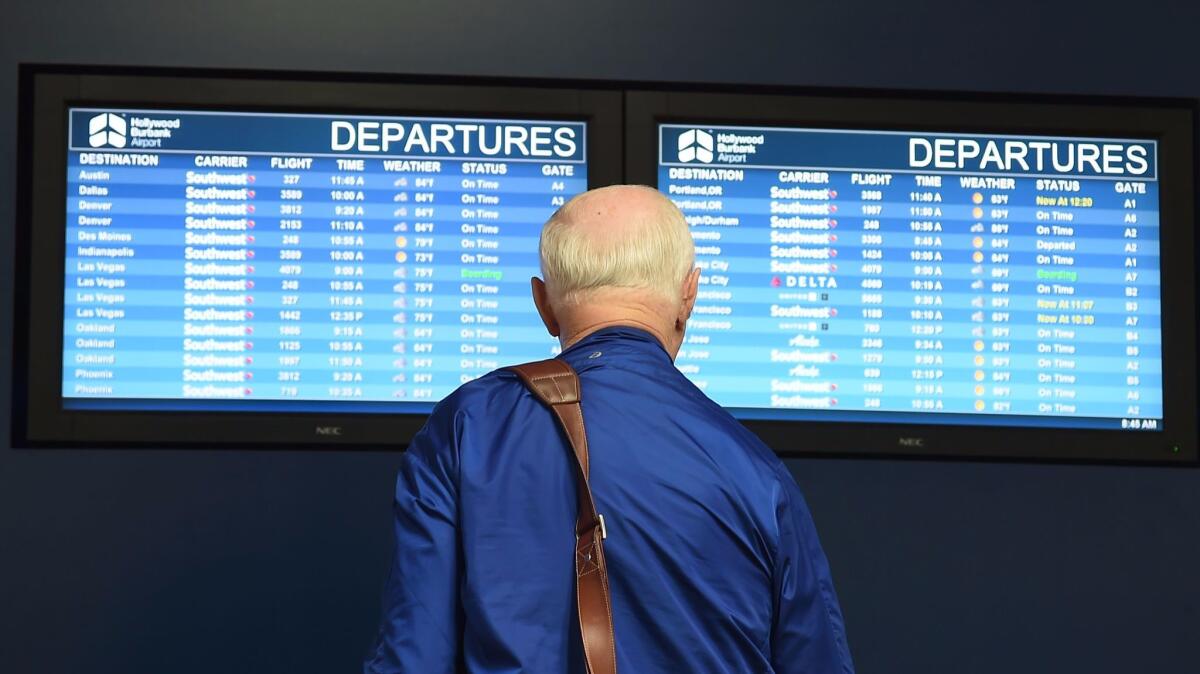Do you have enough time to make that connecting flight? Maybe, but don’t count on it

Question: When one needs to make a connecting flight, say from Frankfurt, Germany, to Milan’s Malpensa in Italy, what is a reasonable layover time to ensure both passenger and bags get to the same place at the same time?
Melanie Gnad
Simi Valley
Answer: There is what is allowable, or “legal” in airline parlance, connect times, and there is what is reasonable, and these often are not the same.
“Airlines frequently sell you on what they call ‘legal’ connecting times, which means if you’re under 25 and wearing track shoes, you just might make it,” Mark Anderson of Adventure Vacations said in an email.
“Most times you can, but if there is any sort of delay it can knock down your itinerary like a set of dominoes.”
Welcome to the complex and confusing world of minimum connecting times, or MCT, which are established largely by the airlines. These are built into the ticket configurations you can create when using an online booking engine or are evident to a travel agent or other entity issuing tickets.
Consumers generally won’t have access to the complete listing of all MCTs, but you can Google your flight and your airports and “connect time” and get a better idea.
But that is a static formula. The airline takes into account the variables of its own operations and the airport you’re connecting in, but it can’t always account for the variables that come with conditions at the airport, the ticketing for your trip, the weather, and your level of fitness and ability to decipher airport signage.
That’s why Anderson provides extra time: “I always allow three hours for international and two hours for domestic,” he said in an email.
Here is what you need to know to gauge whether you’ll have enough time:
Is there construction at the airport?
The answer is probably yes, at least domestically. About $32.5 billion in improvements is needed from 2017-2021, according to the Airport Consultants Council’s 2017 report, most of which involves reconstruction and compliance with Federal Aviation Administration standards, the report says (and not as much involving capacity and terminals).
How can this foul you up? Let us count the ways, which include late flights because of, say, runway closures.
Self-defense: Look at the airport website. If, for instance, you look at LAX’s website, you’ll find construction alerts, and they speak volumes. If the airport does, add time.
Does the airport have other issues?
“Other issues” may involve the configuration of the airport. Does it have more than one terminal, as does LAX? That will take more time if you’re coming into one terminal and going out from another.
Does it rely on intra-airport transit, as does Dallas and Washington’s Dulles? You’ll need to find your way to the conveyance and make sure you don’t get on the wrong one as I did recently at Dulles. (I had plenty of time so it was a slight detour, not a disaster.)
If there is not a method of transportation, look at the sheer size. The biggest footprint of any airport in the world is said to belong to King Fahd airport in Saudi Arabia (more than 300 square miles), but much of the facility is still being built.
Monster No. 2: Denver, about 53 square miles, according to the World Atlas. That makes Chicago’s O’Hare look positively shrimpy at about 10 square miles, but neither of these places is a walk in the park.
Self-defense: Look at gate configurations and where they are in relation to one another. You may be a track star, but if you’re toting a bag and you’re racing through the airport when it’s congested, you’ll be slowed down. If gates are scattered or in other terminals, add time.
Are you taking the same airline on your connecting flight?
If yes, breathe a little bit easier. Airline gates tend to be clustered within one area, the key here being “tend to.”
Self-defense: Look at the airport’s map with proximity in mind.
If you’re not on the same airline, breathe a lot harder because this could mean three things:
— Your new gate may not be close.
— If your bag is not checked all the way through, you’ll have to claim it and recheck it.
— If you have to change terminals, you’ll have to go through security all over again.
Self-defense: Any of those three? Add time. All three? Triple the time.
Is yours the last flight of the day?
Red lights should be going off. Oh, you may be in plenty of time to make your connection, but your connection may never get to you, said Tom Spagnola, a senior vice president of supplier relations for CheapOair.com.
If the last flight of the day is canceled, you’ll be spending the night where you are and trying to muscle your way onto the first available flight.
With load factors — how many seats are taken — frequently 85% or more, you could be in a pickle.
An even bigger pickle: If you are booked on one airline, that airline will try to accommodate you, but if you have two separate tickets, one on airline A and one on B, you’re on your own.
And even if the whole-ticket airline does help you, if the cancellation or delay was caused by weather or other factors out of the airline’s control, the airline is not obligated to put you up in a hotel.
Self-defense: Know if it is the last flight of the day and try not to do this, unless you have no other choice.
Do you have to go through customs?
Will automatically add time.
If you’re coming into the U.S. from abroad, you will have to clear U.S. Customs before you can go on to your next flight.
And don’t count on what U.S. Customs and Border Protection calls “pre-clearance locations” to make that process any faster.
Those locations — there are more than a dozen of them — allow you to clear U.S. Customs in a foreign airport.
This worked in my favor in July coming back from Dublin, Ireland. (Both it and Shannon Airport have pre-clearance.) It was fairly chaotic and time-consuming, but I had plenty of time because I had arrived obsessively early at the airport.
When I deplaned at Dulles, I had only to scoop up my bag and go recheck it because I was, in fact, traveling on two tickets — the return half of a round-trip to Dublin and the return half of a round-trip from LAX. I had plenty of time to enjoy the fabulous airport ambiance between flights, but I wasn’t quaking either.
But I was shaken the previous month coming back through Toronto’s nightmare of an international airport, where I was connecting from another Canadian airport that didn’t have pre-clearance. Toronto did.
A travel agent, who has access to minimum connecting times, booked that ticket, but she has no crystal ball. No way could she know that my flight from Prince Edward Island in the Canadian Maritimes — the first flight of the day, no less—would be late leaving and thus landing.
I watched helplessly as the rest of my itinerary, which involved four more flights in the next two days, collapsed like a house of cards.
Next time I’m headed back to the U.S. through Toronto — if there is a next time — I will ask to allow more time because even if my flight hadn’t been late, Customs was jammed.
Self-defense: Figure Customs into your equation. Check out where there is pre-clearance and how that could factor into your itinerary.
Here’s the best advice about connections: Don’t. Nonstop is almost always better. If you must, try to stay with the same airline, which will help you. If you cannot stay with the same airline (or choose not to, because the “hacker” fares that involve two airlines are often cheaper), allow yourself plenty of time. And maybe find a travel agent who can book your ticket, which they’ll find easier to manipulate than you will using an online travel agency.
Usually, Spagnola said, you can stay up to four hours at your connecting airport without paying more. An agent can help you do that.
“Better to be relaxing in the airport lounge with a good book or a celebratory lunch,” agent Anderson said, “than be in a hell-bent-for-Alaska panic trying to make that too-tight connection.”
Amen.
Have a travel dilemma? Write to travel@latimes.com. We regret we cannot answer every inquiry.
More to Read
Sign up for The Wild
We’ll help you find the best places to hike, bike and run, as well as the perfect silent spots for meditation and yoga.
You may occasionally receive promotional content from the Los Angeles Times.







